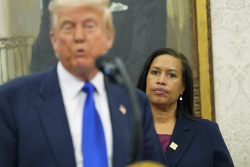In a potential war with either Nicolas Maduro’s military and/or Venezuela’s massive, powerful drug cartels, the USS Iwo Jima would be instrumental in multi-phased operations.
In the volatile landscape of Latin American geopolitics during the second presidency of Donald Trump, the USS Iwo Jima (LHD-7) has sailed into the fray. This Wasp-class amphibious assault ship—America’s miniature aircraft carrier—was commissioned in 2001 and named after the iconic Battle of Iwo Jima in the Pacific Theater of World War II.
Amid escalating tensions with Venezuela’s socialist dictator Nicolas Maduro over that regime’s alleged support for drug cartels in the region, the USS Iwo Jima could play a pivotal role in any hypothetical US military intervention. With recent US deployments of warships and Marines to the Caribbean targeting Latin American drug cartels, including those linked to Maduro, the ship’s amphibious capabilities positions it as a vital strategic asset in any potential US attack on Venezuela.
Indeed, the importance of amphibious assault ships cannot be overstated in today’s world—especially as the United States and the People’s Republic of China are increasingly marching toward a major conflict with each other. Both sides, in such a fight, would rely upon amphibious landers (amongst other assets) to duel each other on the High Seas.
The USS Iwo Jima’s Specifications
- Year Introduced: 2001
- Number Built: 8 (in Wasp-class; 7 operational)
- Length: 843 ft (257 m)
- Beam (Width): 104 ft (31.8 m)
- Displacement: 40,500 tonnes
- Engines: Two boilers, two geared steam turbines (70,000 shp)
- Top Speed: 22 knots (25 mph, 41 km/h)
- Range: 9,500 nmi (10,900 mi, 17,600 km)
- Armaments: Rolling Airframe Missile (RAM) launchers; Phalanx CIWS for air and missile defense
- Crew: 1,000+ sailors, ~1,900 Marines
The USS Iwo Jima has a storied history rooted in the United States Navy’s amphibious warfare doctrine. Built by Northrop Grumman in Ingalls Shipbuilding, Mississippi, it was launched in 1998 and entered service as the seventh ship in the Wasp-class, designed specifically for expeditionary strike operations.
The main potency of the Iwo Jima in combat comes from its air wing. The amphibious assault ship carries more than 30 aircraft, including MV-22 Osprey Tiltrotors, CH-53 Sea Stallion helicopters, and F-35B Lightning II fifth-generation multirole stealth warplanes. For amphibious operations, it holds up to three Landing Craft Air Cushion (LCACs) or up to 61 Amphibious Assault Vehicles (AAVs).
The ship’s operational history includes multiple combat deployments, such as supporting Marine Expeditionary Units (MEUs) in the Mediterranean Sea and Persian Gulf, where it demonstrated versatility in humanitarian aid, counter-piracy operations, and combat support during the various engagements in the Global War on Terror (GWoT).
In 2025, the ship participated in Composite Training Unit Exercise (COMPUTEX), honing its integration with joint forces, including space-based radar for enhanced intelligence. These exercises underscore its readiness for high-stakes scenarios, much like a potential Venezuela conflict.
In a way, then, the Pentagon’s decision to make the Iwo Jima the centerpiece of this flotilla off Venezuela’s coast is a test of her capabilities. It is, in effect, a preview of what is likely to come in any campaign against Beijing for dominion over the Indo-Pacific.
Understanding the Iwo Jima’s Mission
As for any potential fight in Venezuela, the Iwo Jima would serve essentially as both a floating command-and-control center as well as a mobile airfield and troop transport, projecting power in littoral environments, such as Venezuela’s coastline.
Under Nicolas Maduro, Venezuela’s armed forces are thought to rank around fiftieth in the world in terms of strength, out of the 145 nations measured by Global Firepower. The Venezuelan military boasts around 120,000 active personnel, but plagued by equipment shortages and severe corruption. Indeed, much as in other fragile states like Egypt and Pakistan, the Venezuelan high command has turned to commercial ventures, including those of a less-than-legal nature, in order to boost their personal fortunes. One way to look at the Venezuelan regime and its military is less as a regular nation-state and military and more of a well-armed gang whose leaders are always looking for the biggest slice of the proverbial pie. To support the regular army in the event of a conflict with the United States, Maduro has also announced the mobilization of 4.5 million “Bolivarian militia,” a Maoist-like guerilla force supposedly loyal only to Maduro.
The Venezuelan civil-military alliance, led by loyalists like Defense Minister Vladimir Padrino López, integrates the military with the “Cartel of the Suns,” a narco-trafficking network that serves essentially as a Venezuelan state-run drug cartel. Of course, López’ loyalties to Maduro are uncertain; one Venezuelan expatriate has informed me on background that López is “in secret talks” with the Trump administration to “hand over” Maduro “at the right time” to the Americans in exchange for a cessation of hostilities from the American side. This reporting is unconfirmed and single-sourced, but is worth mentioning because the Trump administration would clearly prefer to have a relatively bloodless outcome to their current spate of tensions with Caracas.
America’s State Department has designated Maduro as the head of the Cartel of the Suns, accusing the group of flooding the US with cocaine alongside other criminal groups. Indeed, these groups—such as Venezuela’s “Tren de Aragua” prison gang and Mexico’s Sinaloa Cartel—have been labeled “Foreign Terrorist Organizations” (FTOs) by Trump’s Department of State. What’s more, Tren de Aragua has expanded operations significantly, exploiting Venezuela’s instability to control smuggling routes through porous borders with neighboring Colombia.
US intelligence directly ties Maduro to these syndicates, fueling calls for intervention to dismantle both the regime and the cartels.
The Capabilities of the Iwo Jima in a Fight with Maduro
In a potential war with either Nicolas Maduro’s military and/or Venezuela’s massive, powerful drug cartels, the USS Iwo Jima would be instrumental in multi-phased operations. Initially, it could support US efforts by launching helicopter raids to neutralize coastal cartel strongholds, such as ports in La Guaira used for drug shipments.
With its air wing, the ship could provide close-air support (CAS) against Maduro’s aging Russian-built Sukhoi fighter jets or militia positions, while LCACs delivered special operations forces to interdict cartel labs in the Orinoco River basin.
Amphibious assaults would target key military installations, like the Venezuelan Navy’s bases in Puerto Cabello, overwhelming defenses with Marine landings. The ship’s integration with the Iwo Jima Amphibious Ready Group—including three Arleigh Burke-class destroyers already deployed off the coast of Venezuela—would enable blockade enforcement, cutting off cartel supply lines and Maduro’s Russian-supplied arms.
Furthermore, in urban warfare scenarios against cartel-controlled areas in the Caracas slums, the USS Iwo Jima would insert rapid reaction forces, coordinating with America’s drone force to dismantle the Cartel of the Suns’ leadership.
This approach aligns with Trump’s 2025 directive to use military assets against FTO-designated cartels, potentially leading to regime change. Risks include asymmetric threats from those aforementioned militia groups, but the ship’s defensive systems and Marine firepower would likely mitigate their threat—at least if the mission remains narrow in scope and objectives.
Ultimately, the USS Iwo Jima is the centerpiece in addressing the perceived threat that Nicolas Maduro’s military poses to the United States and its forces deployed throughout the region. As tensions peak with US warships en route and Venezuela fortifying its borders, the Iwo Jima’s deployment could easily tip the scales in a conflict aimed at restoring stability and curbing the drug trade.
Of course, the Venezuelans, like the Houthi rebels of Yemen, are keen on expanding their asymmetrical threat to America’s overwhelming conventional military advantages. Drone swarms and other unconventional attacks could become a real headache for the US warships off Venezuela’s coast.
Yet it is important to remember that Venezuela’s anti-access/area-denial (A2/AD) capabilities are far less advanced than even what Yemen’s Houthis possess. And if the Iwo Jima and the other American forces in the region act fast and decisively enough, they will be able to mitigate whatever threat Venezuela poses to them while still fulfilling their objectives.
In an era of hybrid warfare, vessels like the Iwo Jima remain vital for US strategic interests in Latin America.
About the Author: Brandon J. Weichert
Brandon J. Weichert is a senior national security editor at The National Interest. Recently, Weichert became the host of The National Security Hour on America Outloud News and iHeartRadio, where he discusses national security policy every Wednesday at 8pm Eastern. He is also a contributor at Popular Mechanics and has consulted regularly with various government institutions and private organizations on geopolitical issues. Weichert’s writings have appeared in multiple publications, including The Washington Times, National Review, The American Spectator, MSN, The Asia Times, and others. His books include Winning Space: How America Remains a Superpower, Biohacked: China’s Race to Control Life, and The Shadow War: Iran’s Quest for Supremacy. His newest book, A Disaster of Our Own Making: How the West Lost Ukraine is available for purchase wherever books are sold. He can be followed via Twitter @WeTheBrandon.
Image: Wikimedia Commons.
















